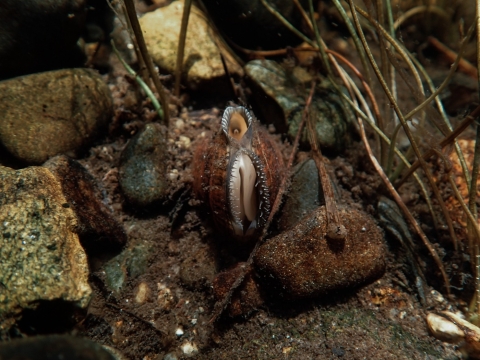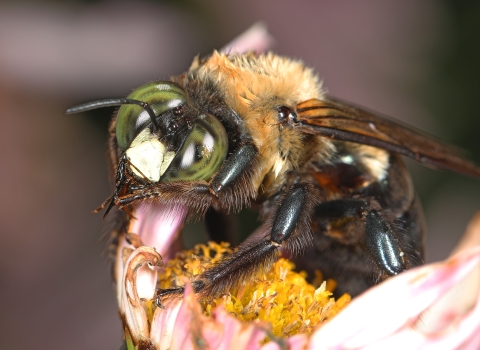Squeezing into wetsuits, defogging snorkel masks, and plunging into chilly rivers is a typical routine for biologists and students surveying for freshwater mussels.
An aquatic ecologist for the Massachusetts Division of Fisheries and Wildlife’s Natural Heritage and Endangered Species Program, Jason Carmignani is in his element underwater, quickly pointing out for students and volunteers how to identify the different mussel species they are looking for in a reach of the Ware River in late August.
As the survey begins, the team spreads out across the width of the river, each surveyor claiming an invisible lane to snorkel along. The work to scan every nook and cranny of the river bottom is slow and meticulous, requiring focus to detect the smallest sign of a mussel filtering water, or to spot a silt-covered, camouflaged mussel wedged between river rocks. As the team moves upstream together in a line, they silently count the eastern elliptio mussels, the triangle floaters, and creeper mussels. Occasionally, other aquatic life interrupt by swimming into view, like schooling minnows and one stealthy snapping turtle that caught me off guard.
“For this survey, we’re specifically looking at freshwater mussels and trying to prevent any mortality for state-listed species in the Ware River, like the creeper,” Carmignani explained. “We’re conducting surveys to find places we can put these mussels that are just downstream of the Wheelwright Dam, before the dam removal project begins.”
The goal of the survey is to better understand the habitats these mussels use in the Ware River ahead of the planned removal of the Wheelwright Pond Dam, a process that will take several years.
But the survey is also part of a regional effort supported by a Competitive State Wildlife Grant from the U.S. Fish and Wildlife Service to coordinate conservation of the brook floater, a priority at-risk species, and one of many freshwater mussel species that have experienced dramatic declines over the last century. More than 75 percent of native freshwater mussel species in the U.S. are either listed as endangered or threatened, considered to be of special conservation concern, or are presumed extinct.
That’s bad news for wildlife, and people. Mussels play an integral role in river ecosystems, serving as a food source for many small mammals, birds, fish, turtles, and other invertebrates. Individual mussels can also filter up to ten gallons of water a day, removing excess nutrients and pollutants suspended in the water and improving the overall river health and water quality.
Fortunately, projects like the removal of the Wheelwright Pond Dam, and the work to assess mussel populations beforehand, will benefit the entire aquatic community.
A new approach
In 2018, the Massachusetts Department of Fish and Game’s Division of the Ecological Restoration announced plans to remove the Wheelwright Pond Dam on the Ware River, one of many priority projects across the Commonwealth to restore and protect critical environmental resources. The project will use a new dam-removal method of slowly lowering the water level behind the dam over the next several years to minimize disturbance to the wildlife both upstream and downstream.
Once completed, the Wheelwright Pond Dam removal will open miles of river, estuaries, and wetlands upstream, restoring the natural river process that helps prevent water damage and flooding from large storm events. That will expand opportunities for recreation, and open more habitat to fish species like eastern brook trout and freshwater mussel species like the brook floater.
The brook floater is a small, stream-dwelling mussel that depends on clean, flowing water and substrate that they can safely anchor themselves in while filter feeding. They can be found in 14 states in the eastern U.S., the District of Columbia, and Canada.
Like many freshwater mussels, brook floater and their habitat are vulnerable to pollution, development, invasive species invasive species
An invasive species is any plant or animal that has spread or been introduced into a new area where they are, or could, cause harm to the environment, economy, or human, animal, or plant health. Their unwelcome presence can destroy ecosystems and cost millions of dollars.
Learn more about invasive species , and changes in temperature and precipitation resulting from climate change climate change
Climate change includes both global warming driven by human-induced emissions of greenhouse gases and the resulting large-scale shifts in weather patterns. Though there have been previous periods of climatic change, since the mid-20th century humans have had an unprecedented impact on Earth's climate system and caused change on a global scale.
Learn more about climate change . The freshwater mussel surveys and monitoring in the Ware River lets biologists assess the health of their habitats and population to determine how best to protect them.
“There are only four populations of brook floater in Massachusetts,” explained Carmignani “If the habitat upstream looks good enough after the dam removal, we could potentially reintroduce brook floater in new habitat and create some redundancy for the population in the Ware River.”
Across the region, the Competitive State Wildlife Grant project is helping to align conservation efforts for brook floater throughout Massachusetts, Maine, New Hampshire, New York, and Virginia. The grant, administered by the Wildlife and Sportfish Restoration Program, led to the formation of a multi-partner brook floater working group, the creation of standard survey protocols and advanced techniques for rearing the mussels in the lab for release back into the wild.
“This has been a highly successful collaboration across the region led by Massachusetts,” said Nick Popoff, Service fisheries biologist. “This effort prioritizes management of freshwater mussels with partners across state boundaries and is the essence of what Competitive State Wildlife Grants aims to accomplish.”
Thanks to the contributions and collaboration of partner agencies, brook floater are being stocked in some rivers with the hopes of expanding stocking efforts throughout its range.
Hopefully in time, snorkel surveys like the ones Carmignani led this summer will reveal more brook floaters making their home in healthy river bottoms across the Northeast.




